Bornholm
Bornholm is Denmark's crown jewel. The "Pearl of the Baltic" has sandy beaches on the south of the island which are renowned for their Mediterranean light and feel. Its forests impart a more rugged feel than found elsewhere in densely-populated Denmark. Though practically unknown to most English speakers, this island of light is a favorite vacation spot for Scandinavians, Germans, and Poles. Its position in the middle of the Baltic (it is closer to Sweden, Poland and Germany than to rest of Denmark) gives both a secluded, yet international feel.
Bornholm is an island located in the Baltic Sea 37 km south of Sweden. The island is roughly 588 square kilometres and has 158 km of coastline. Bornholm is widely known for its smoked herring, high quality arts and crafts and its beautiful nature.
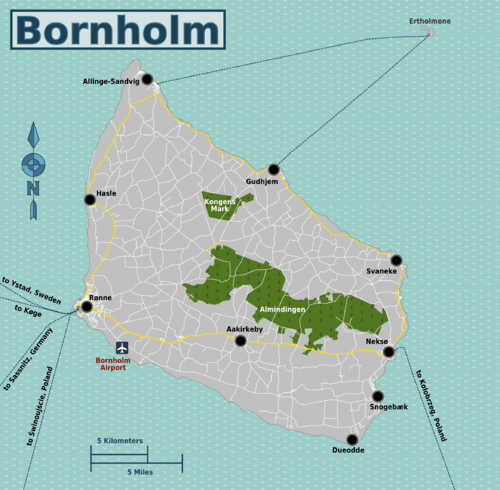
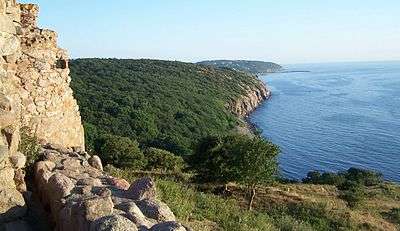
Regions
As of January 2003 Bornholm's five regions assembled into one administrative and political unit called Bornholms Regionskommune. In January 2007, Bornholm was joined with the Capital Region (Hovedstadenregionen), meaning that Bornholm is now administratively fused with Copenhagen.
Cities
Other destinations
- 🌍 Dueodde — protected beach and site of tallest lighthouse on island
- 🌍 Ertholmene — small group of islands
- 🌍 Hammershus — large medieval fortification
History
Bornholm has a long history as a military and political center in the Baltic ocean. The history goes back to the famous Vikings. Numerous findings at southern Bornholm indicate that Bornholm was a well established trading point. Poland, Sweden and Germany are all within 100 km. That made Bornholm attractive for the Danish king, the archbishop of Lund and the city of Lübeck during medieval times. Catholics who fasted were only allowed to eat fish and other similar things, so that in the 13th century herring was the main income source on Bornholm.
Medieval
The European plague struck Bornholm in the middle of the 14th century and halved the population. It was also during this time that Hammershus was constructed, as well as the famous 'round churches'. From 1525 to 1576 Bornholm was pawned to Lübeck in payment for debts the Danish king Frederik I incurred as a result of Lübeck's support for his rebellion against the Swedish King Christian II. The people of Bornholm were suppressed with high taxes and forced labor. They tried to break free but the revolt was quashed in the battle of Ugleenge.
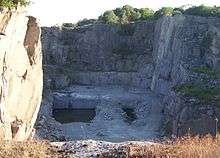
Early Modern
A battle between Denmark and Sweden in 1645 led to Swedish control over the island, but it was brief - they left again the same year. In the Roskilde Peace of 1658, Bornholm, Skåne, Halland and Blekinge were given to Sweden. Again the people were forced to pay high taxes to oppressive forces. The Danish king advised the people of Bornholm to fight back. In 1658 the Swedish commander of Bornholm was killed in Rønne, and the people of Bornholm freed themselves from years of foreign command. Bornholm was given to the Danish king as 'his island'. Jens Kofoed, Poul Anker, Peder Olsen and Villum Clausen became champions of liberty. The same four men have, in modern times, given their names to the ferries from Bornholmstrafikken.
World War II 1940-1946
Bornholm was Danish until World War II, when it was occupied by the Nazis along with the rest of Denmark. The island was liberated by the Soviets in 1945, but against the backdrop of the emerging Cold War, they refused to withdraw until they were given some special privileges.
The Cold War 1946-1989
Bornholm was NATO's fist towards the east, but a Soviet declaration after World War II stated that the placement of "foreign soldiers" (NATO) on Bornholm wasn't allowed. So, it was only Danish soldiers who were allowed duty at Bornholm. Because they were able to listen to Soviet, Polish and East German military radio transmissions from a location much further to the east than any other NATO members, enabling military movements and reinforcements deep within the Soviet Union to be monitored, Denmark's contribution to shared NATO intelligence was very highly valued, particularly at times of international tension. More recently, NATO radar installations have been placed on the island.
Industry
As in other places in the world, Bornholm felt the industrial revolution during the 19th century, and in 1843 its Hasle klinker (clinker) was established. It was one of Bornhom's biggest export ventures since the herring in the Middle Ages. Also, the underground of Bornholm was and still is today a major part of the Bornholm industry. Bornholm is an island of Granite. Bornholmstrafikken (formerly known as ‘Dampskibsselskabet af 1866’or The Steamship Company of 1866) was founded in 1866 and is still the regular route to and from Bornholm.
Bornholm's main income source has, as an island, always been the sea which surrounds it, and in the 1970s through the 1980s the fishermen of the island were so successful that many of them became really wealthy. No one ever wondered about the quantity of fish they pulled up in their boats until the beginning of the 1990s. The harbours and processing facilities were all rebuilt to be prepared for a new season of fishing, but the season was called off by marine biologists. Because of overfishing, the sea was empty, there were no fish in it. That led to a crash in the industry because one man at sea could keep six on shore at work – in processing facilities, shopping, service and maintenance.
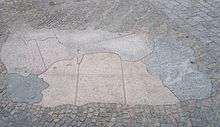
Tourism
Today Bornholm is a popular travel destination for many people in the Baltic region as well as tourists from Sweden, Norway, Germany, Poland and the rest of Denmark who are a common sight in the summertime.
Talk
As Bornholm has many tourists each year, most people speak either English, German or Swedish, the exception being most of the older population. Almost all tourism brochures are to be found in English, German, Polish and a Scandinavian language.
Get in
By plane
Bornholm airport near Rønne. In the summer season there are buses from the airport.
All international flights operate on a summer-only schedule:
Domestic flights:
- Danish Air Transport - from Copenhagen (up to six return trips daily)
By car
As Bornholm is an island, you must take one of the various ferries (see below). The fare for a car is usually a lot higher than for pedestrians.
By ferry
These ferries take cars and passengers.
International ferries:
- Bornholmslinjen Ystad - Rønne, Sassnitz - Rønne.
- Bornholmexpress Allinge-Sandvig-Simrishamn only during the summer.
- Kołobrzeg – Neksø ferry from April till October.
- Sassnitz – Rønne ferry from April till October (appears only in Polish language version).
Domestic ferries:
- Bornholmslinjen Rønne – Køge, regular.
By ferry and train
- DSB sells combined train and ferry tickets Copenhagen – Malmö Hyllie – Ystad – Rønne. This journey requires a change at Malmö Hyllie station. There is a very short walk between the train and ferry in Ystad.
Get around
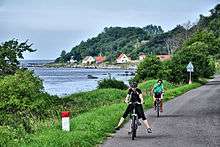
You can get to the island by ferry or airplane, but the island also provides excellent opportunities for arriving by private boat. It's easy getting around either by car, bus or bicycle.
By taxi
You can hail a taxi on the street, or call for one to come pick you up at a specific address. A taxi can be ordered at +45 59 95 23 01.
The charge for a trip from the airport to Rønne is approximately €7, and a trip from Rønne to Nexø (longest distance) is €50.
By bus
There are 9 bus lines connecting cities and attractions. Some stops are designed for getting off, walking a scenic route and getting on a bus at the next stop. Outside the cities there are not many bus stops. You just ask the bus driver to stop where you want to get off. And you wave your hand to stop a bus anywhere where the road doe not have solid white lines (so that the bus will not block the traffic to let you on). At night use a flashlight or a mobile phone to make your gesture visible to the driver.
The BAT 24 hour ticket at 150 kr can be a good deal if you travel a few times and do not want to worry about the rates and zones.
By bike
The easiest way to explore Bornholm is by bike, the longest distance on the island is 36 km. There are excellent biking facilities all over Bornholm.
It is easy to rent a bike at Bornholm an the charge varies from place to place but expect about €10 for a day and €20 for a whole week.
See
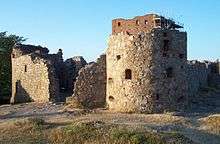
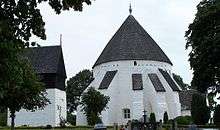
- Almindingen - Third largest Danish forest
- Svaneke A Very well preserved town on the most Eastern point of the island, Svaneke boasts the most hours of sunlight in all of Northern Europe. Known as one of the prettiest and best preserved towns on the island it is also well known for its many artists and galleries. There is a market day on the town square and it is one of the most wonderful things about this town. Wednesday and Saturday from 09:00-14:00 throughout the summer season and only on Saturdays until noon the rest of the year. The market is crowded with people, buying and talking, watching and contemplating... listening to the live music and drinking beer.The requirement for being a vendor here is, you have to have made the wares yourself. There are fresh organic vegetables, battered fried fish, sausages and bitters, photo-cards, jewellery, artworks and crafts, hats sweaters and socks, leather shoes; there is something for everyone here. A big hit with the kids is the horse and buggy ride around the town, picking up and dropping people off on the market. The colourful life of the market on its own is worth the visit. The unique red church from the 1300s is also worth seeing, it is one of the oldest on the island and one of the prettiest too, as it watches over Baltic. Svaneke has two harbours, a larger one and a smaller one for the locals, filled with colourful boats and a nearby seafood smokehouse (with indoor and outdoor dining). But perhaps what this town is most well known for... is its beer. The islands only brewery Svaneke Bryghus has become quite well known all over Denmark. A water tower designed by the architect Jørn Utzon (best known for the Sydney Opera House) in Svaneke. Oluf Høst was born in Svaneke and his house can be seen on OlufHøstgade. There are also many specialty sweet shops in Svaneke, such as handmade candies, caramels, licorice and chocolates, all made in high quality. There is even an organic homemade ice-cream parlour. Svaneke is also one of the only towns besides Rønne that has life even throughout the winter.
- Joboland An amusement park near Svaneke with a small water park, animals and rides.
- Dueodde - white sanded beaches with some of the finest sand in the world.
- Gudhjem The name translates directly to 'God's Home' and is famous for its gorgeous sunrises. The many steep hills leading you farther into town, down towards the harbour, are what is the most charming in the town. Gudhjem is quite dead in the winters but is bustling with tourists in the summer. There are many shops and restaurants and a very large white mill. Right up from Gudhjem is the island's best swimming pool. The water is half-saltwater so as to be able to use less chlorine. There are massive wall to wall and ceiling windows, tropical plants and a waterslide. There is a sauna in both men's and women's changing rooms.
- Allinge-Sandvig These two amalgamated towns on the Northern coast of the island are both romantic and pretty. Allinge is especially lovely and famous for its Smokehouse and its annual Jazz Festival.
- Round churches
- The old part of Rønne
- Slotslyngen - wild nature near Hammershus
- Bornholms Kunstmuseum The largest art collection on Bornholm. Includes such artists as Oluf Host (Høst), Karl Isakson and many others. The museum is most famous for its fantastic architecture and amazing location on the sea side.
- Hammershus A large ruin at the northernmost point of the island.
- The Medieval Centre of Bornholm A small rebuilt city from the medieval times. They have stalls, demonstrations, food, performers and special activities for children. Every year a large market is held for a week in mid-July. Enthusiasts from different countries attend and the centre is turned into a large theatre with all kinds scenes from the everyday-life of the medieval. The climax is a huge battle with cannon smoke, bowmen, tournament on horseback and knights in armor.
Do
- Bicycling
- Sunbathing
- Walk/trekking
- Gallery tours
- Swimming
- Surfing
- Sailing
- Fishing
- Camping
Forests
- Almindingen - The third largest forest in Denmark.
- Paradisbakkerne
- Rytsker Højlyng - Home of 'Rokkestenen' a massive rock approx. 35 tonnes.
Beaches
- Dueodde - The sand is ultra-fine and inviting. The water is clear and clean with lots sand bars, so there is both shallow and deep water close to the shore. The sand is white and if it were not for the pine trees in the distance, one would believe to be in the tropics.
- Balka - Balka is the most popular beach on Bornholm. It is several kilometres long and has very fine sand and shallow water.
- Antoinette - A beach north of Rønne, plenty space to be yourself and enjoy the weather and ocean.
- Hullehavn - A small beach on the outskirts of Svaneke, it's incorporated into the cliffs and even has a divingboard. The beach has camping on one side of it and the lighthouse on the other. Hullehavn is known for how it's easy-going atmosphere. Both locals and tourists enjoy Hullehavn where people are very laid back and sociable; age and nationality means nothing. There is a there is a little bar/cafe/ice-cream/kiosk with tables and chairs right on the beach. There are often concerts and at the cafe and djs and dancing.
Eat
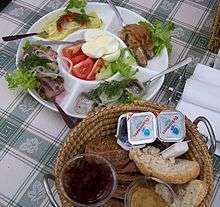
- See also: Nordic cuisine
- Smoked herrings are a specialty of the island. You can get them at smokehouses in seaside towns, such as Arnager, Gudhjem or Snogebæk, where they also sell other fish and seafood delicacies.
- Sol over Gudhjem Smoked herring on rye bread with a raw egg yolk on top.
- Marinated herrings
- Other seafood such as scrimps, salmon, sole and eel.
- Rye crackers made by Johannes Dam in Aakirkeby
- A variety of local cheeses.
Buy
Bornholm is famous for its many high quality crafts such as blown glass and textiles. Visit the different shops and exhibits.
- Glass art. There are many small glass workshops around Bornholm.
- Ceramics
- Granite
Drink
- Bornholmer Bryg. Beer made by Svaneke Bryghus and available in most bars and restaurants on Bornholm.
- Bornholmer Snaps. Snaps made on Bornholm Den Bornholmske Spritfabrik ApS available at almost any Bornholm store.
Go next
Ertholmene islands.